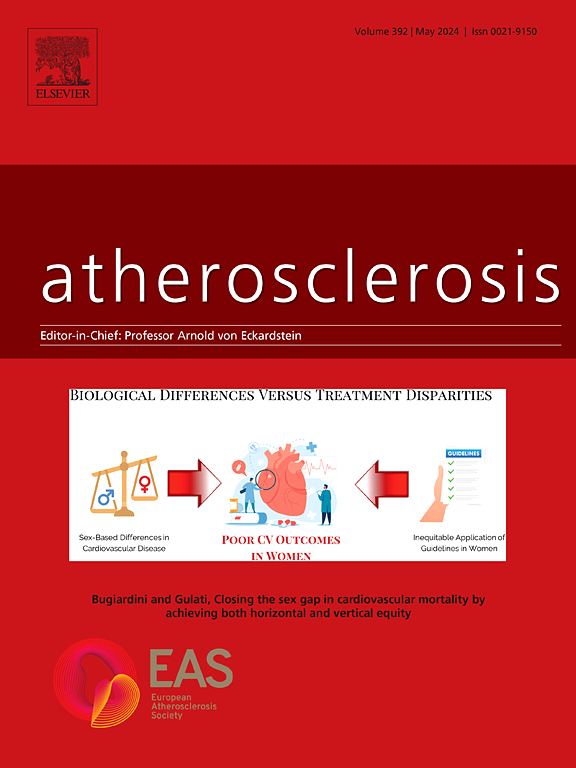Association between statin adherence and arterial stiffness in young adult patients with familial hypercholesterolemia: A cross-sectional study
IF 4.9
2区 医学
Q1 CARDIAC & CARDIOVASCULAR SYSTEMS
引用次数: 0
Abstract
Background
Familial hypercholesterolemia (FH) causes elevated low-density lipoprotein cholesterol (LDL-C) levels, leading to an increased risk for premature atherosclerotic cardiovascular disease (ASCVD). To prevent ASCVD, lipid-lowering therapy (LLT), such as statins, is needed from childhood on, to lower LDL-C levels. Arterial stiffness can serve as a surrogate marker for atherosclerosis. The aim of this study is to determine the association between statin adherence and arterial stiffness in young adults with FH.
Methods
The cohort for this cross-sectional study originally consisted of 214 children with heterozygous FH who participated in a placebo-controlled trial on the efficacy and safety of pravastatin, and all continued on LLT. After 20 years, these patients were invited for a follow-up visit, including a questionnaire where they reported the percentage of prescribed LLT they had taken over the past month, as well as a 4D flow MRI examination to assess carotid pulse wave velocity (PWV), in m/s.
Results
We included 134 patients with FH (mean (SD) age: 31.7 (3.2) years; 67 (50.0 %) males). A higher adherence (%) to statin therapy was significantly associated with lower PWV (beta [β] −0.003 (95 % confidence interval [CI] −0.007 to −0.000); P = 0.039). After adjustment for potential confounders, this association remained similar (β −0.003 (95 % CI -0.007 to −0.000), P = 0.031).
Conclusions
The results of our study suggest that higher adherence to statin therapy is associated with less arterial stiffness, thereby reducing the risk for ASCVD compared to lower levels of adherence. These findings highlight the importance of adherence to LLT in patients with FH.

家族性高胆固醇血症年轻成年患者服用他汀类药物的依从性与动脉僵化之间的关系:横断面研究
家族性高胆固醇血症(FH)引起低密度脂蛋白胆固醇(LDL-C)水平升高,导致过早动脉粥样硬化性心血管疾病(ASCVD)的风险增加。为了预防ASCVD,从童年开始就需要降脂治疗(LLT),如他汀类药物,以降低LDL-C水平。动脉硬度可以作为动脉粥样硬化的替代指标。本研究的目的是确定年轻成年FH患者他汀类药物依从性与动脉僵硬之间的关系。方法本横断面研究的队列最初包括214名杂合性FH患儿,他们参加了普伐他汀的有效性和安全性的安慰剂对照试验,并继续接受LLT治疗。20年后,这些患者被邀请进行随访,包括一份调查问卷,报告他们在过去一个月里服用了规定的LLT的百分比,以及4D血流MRI检查以评估颈动脉脉搏波速度(PWV),单位为m/s。结果纳入134例FH患者(平均(SD)年龄:31.7(3.2)岁;男性67例(50.0%)。较高的他汀类药物依从性(%)与较低的PWV显著相关(β [β] - 0.003(95%可信区间[CI] - 0.007至- 0.000);P = 0.039)。在校正潜在混杂因素后,这种关联仍然相似(β - 0.003 (95% CI -0.007至- 0.000),P = 0.031)。结论:我们的研究结果表明,与较低的依从性相比,较高的他汀类药物治疗依从性与较低的动脉僵硬度相关,从而降低了ASCVD的风险。这些发现强调了FH患者坚持LLT治疗的重要性。
本文章由计算机程序翻译,如有差异,请以英文原文为准。
求助全文
约1分钟内获得全文
求助全文
来源期刊

Atherosclerosis
医学-外周血管病
CiteScore
9.80
自引率
3.80%
发文量
1269
审稿时长
36 days
期刊介绍:
Atherosclerosis has an open access mirror journal Atherosclerosis: X, sharing the same aims and scope, editorial team, submission system and rigorous peer review.
Atherosclerosis brings together, from all sources, papers concerned with investigation on atherosclerosis, its risk factors and clinical manifestations. Atherosclerosis covers basic and translational, clinical and population research approaches to arterial and vascular biology and disease, as well as their risk factors including: disturbances of lipid and lipoprotein metabolism, diabetes and hypertension, thrombosis, and inflammation. The Editors are interested in original or review papers dealing with the pathogenesis, environmental, genetic and epigenetic basis, diagnosis or treatment of atherosclerosis and related diseases as well as their risk factors.
 求助内容:
求助内容: 应助结果提醒方式:
应助结果提醒方式:


